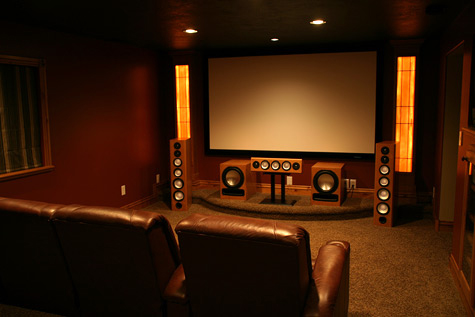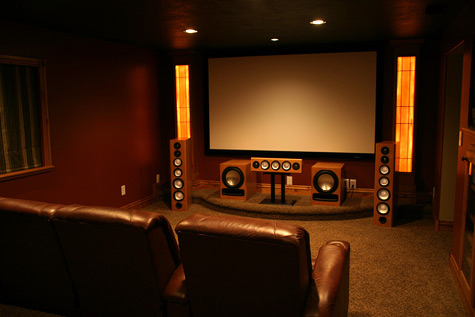The Strange and Confusing World of "Bass Management"
Years ago as a passionate enthusiast, and long before I began editing magazines and writing articles about sound reproduction and video, I was totally convinced that deep bass had directional qualities. I even went so far as to build a large pair of transmission-line stereo subwoofers, great coffin-like enclosures, one for the left channel and one for the right, which stood at the front of the room not far from my satellite main speakers. (My mate at the time predicted I'd likely request burial in one of the subwoofers, so great was my fervor for all things audio!)
Directional Bass?

Back then, two subwoofers for "stereo bass" seemed entirely logical — if you watch a big bass drum in a band being played, or a marching band passing by in a parade, the "whomp" of the bass drum seems to come directly from the drum itself. It took me years to realize that the directional part of the "whomp" sound is in fact at a much higher frequency than the 30-Hz bass energy from the drum. When the mallet strikes the drum's diaphragm, the higher-frequency information provides the directional cues that tell your ear/brain hearing mechanism where the drum is.
But the deep bass energy of the drum's diaphragm pulsing back and forth 30 times per second radiates long pressure waves in all directions and it's that bass energy that gives the drum its power. And that is exactly the energy the subwoofer produces so well, while the smaller satellite drivers — even the compact surrounds in a 5.1-channel system — handle the initial mallet sound to tell you the drum's location. The same thing happens with soundtrack special effects like explosions or thunder and lightning. The crack of the lightning or initial explosive burst is higher in frequency and gives you the directional information, so the midrange driver and tweeters (or upper-bass octaves of the woofer) easily reproduce those sounds. But the deep bass reverberations of thunder go to the subwoofer.
Crossovers and Filters
Once you understand this, then the operation of a multi-channel satellite/ subwoofer system becomes clear, as well as the concept of "bass management." To function properly, the system must extract the deepest bass energy of the drum or explosion from the rest of the audio signals and send it to the subwoofer — in other words, the non-directional parts of the bass below 100 Hz (approximately).
To divide the bass frequencies from the high frequencies and direct them to the drivers best equipped to reproduce them, we use filters. Operating together these filters make up a "crossover." Most crossovers are comprised of a "low-pass filter" and a "high-pass" filter. The low-pass filter lets the low bass through (passes the lows) but blocks the high frequencies from the subwoofer (or woofer). The high-pass filter lets the higher frequencies through to the midrange and tweeter but blocks the deep bass from reaching those drivers. This is a typical crossover in a "2-way" system that uses two filters. (It's somewhat analogous to those mechanical change-sorting devices that let the smaller dimes-the high frequencies-pass through a small slot while the larger quarters and silver dollars--the bass frequencies-will only fit through the bigger slots.)
There are also individual crossovers in your main and satellite speakers (you cannot have bass frequencies reaching the tweeter or the tweeter would burn out) but the real work of separating the deep bass from the other frequencies and sending it to a subwoofer in a 5.1- or 7.1-channel home theater system happens inside your A/V receiver. There, an active digital crossover that is part of the "bass-management" circuit can be adjusted to specific frequencies and characteristics that best suit the capabilities of each of your speakers. Every Dolby Digital/dts 5.1 or 7.1 channel receiver (or A/V preamp-processor) has this bass-management circuit with its accompanying menu system that you can access.
Small and Large
In the bass management setup menu, "Small" and "Large" don't refer to the physical size of your speaker enclosures so much as to whether or not each speaker in the system is capable of reproducing powerful deep bass below 80 Hz (note the emphasis on "powerful"). Nevertheless, the basic rules of physics that dictate small boxes cannot reproduce powerful deep bass can be used as a rough guide to manually adjusting your home theater's bass management.
For example, typical center-channel and surround speakers (and in lots of systems, the main speakers as well) are relatively small so as not to be obtrusive. Most well-designed ones of ample size (not the mini-cubes) will reproduce upper bass — from around 100 Hz and above-smoothly and consistently.
But when deeper bass frequencies below 100 Hz reach those speakers, the satellites do not have the power and air-moving properties (i.e., large-diameter cones) to adequately handle the bass, so the speaker's bass output begins to "roll off" or diminish. That's why you should set your center channel and surround speakers (and the mains if they are bookshelf size) to "Small" in your AV receiver's bass-management menu. The receiver's circuitry then inserts electronic high- and low-pass filters at a preset frequency (or one you manually select) at, typically, 80 Hz or 100 Hz.
80 Hz
Why 80 Hz? Because deep bass below that frequency (the aforementioned energy of the bass drum) is not directional; it's just low-frequency energy that needs the big woofer of a subwoofer (plus its powerful self-contained amplifier) to generate. So that's the process you trigger when you set your center and surround speakers to "Small". The receiver's bass management circuit routes the deepest bass to the subwoofer and all the upper bass and highs to the center and surround speakers (and to the main speakers if they are bookshelf models).
Note too that the digital filters inside your AV receiver don't just suddenly cut off all frequencies at 80 or 100 Hz. They have "slopes," so the process of extracting deep bass is a gradual one - as the bass gets deeper, the crossover filters remove more and more of it for the subwoofer and gradually send less of it to the smaller satellite speakers. The bass frequency ranges of sub and satellites overlap, so a seamless and inaudible transition occurs between the subwoofer and your center and surround speakers' upper bass and midrange. That's why you shouldn't notice or "hear" deep bass from the subwoofer in a conventional sense. Properly set up, the deepest bass should seem to come from the main front speakers in your system, because the sub is only supplying the lowest energy component of low-frequency sounds. (Depending on where the subwoofer is located you may hear knick-knacks vibrating or resonanating — even picture frames — which are set into motion by the bass energy from the sub.)
Audio and home theater enthusiasts often worry about "losing bass from the QS8s or the rears" as one Axiom customer recently put it. That would only occur if he were to set his surround speakers to "Large." Deep bass would then be sent to the surrounds, which aren't able to produce deep bass.
If you use floorstanding front left and right speakers, most receivers enable several options that let you set the mains to "Large" and choose whether or not to have the AV receiver also direct bass to the subwoofer. That may work well in lots of rooms, but be certain that your AV receiver's bass management filters also direct bass from the center and surrounds to the subwoofer and/or to the Large mains. Most do.
DVD-Audio and SACD
In this discussion, I've ignored the issue of bass management as it applies to DVD-Audio and SACD, partly because the history of the two formats is checkered with missteps and false assumptions on the part of the hardware developers and mixing engineers. Nevertheless, since a small percentage of enthusiasts, including this writer, have experimented with both formats and value SACD or DVD-Audio recordings when they are well done, some comment is required.
Five Big Floorstanders
When the formats were introduced, there was a movement to have all the speakers in a DVD-A or SACD playback system be large, floorstanding speakers-impractical for all but those with extremely large listening rooms and the patience to try and position themselves in the middle. In such a setup, the DVD-A or SACD player would output full-range signals to all channels. From a practical point of view, it quickly became evident that even mixing studios didn't have room for full-range rear monitor speakers so engineers quickly adopted smaller bookshelf models for their studio mixing setups and utilized a separate low-frequency subwoofer channel. Still, the initial approach left a residue of belief that for "true" DVD-Audio and SACD playback, large full-range rear speakers were required. Worse, many early DVD-Audio and SACD players lacked proper bass-management circuitry. A few A/V receiver processors permitted the receiver's bass-management circuit to operate using the multi-channel inputs normally reserved for DVD-Audio and SACD playback.
No Delay
Complicating the issue was the fact that early DVD-A and SACD players did not incorporate digital delay for the rear channels, with the result that if the seating area was even a few inches closer to the rear speakers than to the front, you'd hear the rear channels before the sounds from the front, and the imaging would collapse to the rear speakers, which ruined the multi-channel illusion. (No domestic rooms are large enough to provide long enough natural delay times to prevent rear speaker sound from confusing your ear/brain hearing mechanism.) That's why all good bass-management circuits must include a distance configuration and mode that inserts appropriate digital delay times for ambient and rear-speaker sound output. Delayed by 15 to 30 milliseconds or more, the rear-channel or ambient sounds arrive a split second after those from the front, which keeps our ear and brain happy in forming the illusion of a complete 3-dimensional soundstage that approximates what might occur at a concert, club or outdoor event.
The happy solution is that accurate music-only DVD-Audio or SACD playback does not suffer when properly processed through an AV receiver's internal bass management circuit or external processor. The low frequency foundation of jazz, rock or orchestral music still goes to the subwoofer, leaving the smaller surrounds, center (and bookshelf main speakers) to handle all the upper bass, midrange and highs.
And to reassure those with lingering doubts, smaller surround speakers like Axiom's QS8s or QS4s, or direct-radiating surrounds will deliver highly convincing multichannel DVD-Audio or SACD playback so long as the signals go through proper bass management and delay circuitry with a subwoofer to properly convey the deepest bass in the music.





